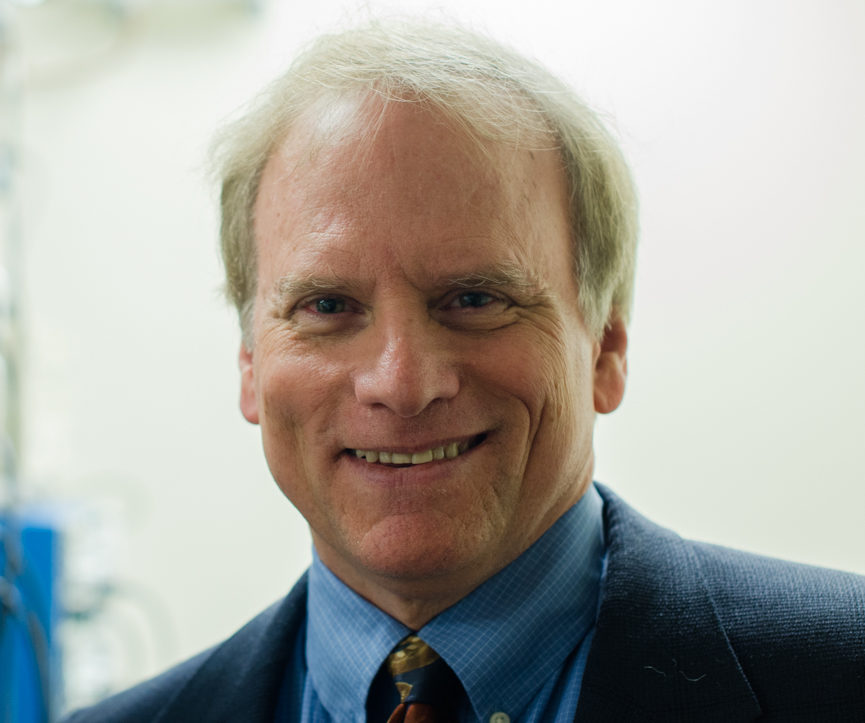
Expert Dive: Empowering Students Through Inquiry-Guided Learning
By Jeffery Galle
Redesigning a course to incorporate an exciting pedagogy like inquiry-guided learning can kindle tremendous enthusiasm for a course taught for many years, and such courses can fuel students’ curiosity.
Virginia Lee, an inquiry-guided learning consultant, defines inquiry as “increasingly, independent investigation of  questions and problems for which there are no single answer.”
questions and problems for which there are no single answer.”
When Emory’s Oxford College, where I served as director of the teaching center, began a curricular exploration of inquiry-guided learning, I wanted to participate. There, the focus is on the first two years of undergraduate study, and I had taught many graduate courses at a previous institution. I wondered if I could redesign the literary criticism course I had offered to masters students using inquiry-guided learning.
Course redesign
A literary criticism course offered in the traditional manner typically focuses on a chronology of successive schools of literary interpretation, beginning with interpretive essays of the late 19th century and continuing with the tenets and terms of a myriad of theoretical approaches. An intoxicating temptation in such courses is to plunge into the theories of interpretive strategies to the neglect of students’ actual critical development. The course can become more a history of thought, not a course in writing literary interpretations. Recasting literary criticism as an inquiry course challenged my students to stretch their critical capacity and to learn more theory than ever.
First, the theory book gave way to a volume of classic short stories. The daily assignment was to read a story and write a set of questions the story raised. From these questions, we created an elementary taxonomy—questions of fact, of character, of motivation/cause, of impact and resulting significance. To answer the most difficult questions, students examined theoretical essays outside of class and brought their ‘discoveries’ to class for discussion. In a series of staged writing assignments, students joined questions to terms with 1-page short applications and up to 6-page analyses.
Students learned to become literary critics by doing interpretation—reading, identifying the puzzles a story presented by raising questions (and refining them each day), and then writing short papers which gave way to full-length essays. After we finished the book of classic short stories, students picked up the second required book, a collection of short stories recently published. In working with the new short stories, students literally wrote original interpretive essays for stories without any critical history.
Challenges
The project also involved many setbacks; in fact, challenges to independent inquiry became quickly apparent. First, with too little support of the theoretical and course content, students have nothing to reason with or to apply. Second, with too much support, faculty can enervate the inquiry spirit that is so innate to curiosity. Hence, the degree of support which we call scaffolding and the timing of the scaffolding in a just-in-time approach are inquiry teaching skills that faculty often pick up with trial and error.
Key takeaways and recommendations
For those interested in incorporating inquiry-guided learning into their courses:
- Start small. Begin by modifying one or two assignments to include an inquiry element rather than trying to revise a full course.
- Frame the assignments around a problem that sparks curiosity.
- Scaffold students’ learning of course content as they develop ways to solve the problem.
Challenges notwithstanding, this pedagogy enhances student learning. In fact, two published collections of essays emerged from this effort, and faculty from nearly every discipline contributed essays to the books. Conversations with faculty from many institutions and across the disciplines at the college institute, the Institute for Pedagogy in the Liberal Arts, sparked faculty interest in pursuing publication of their classroom experiments. I wrote a book proposal with my colleague Rebecca Harrison, who attended several institutes, and the accepted proposals turned into two books. If ever again I teach literary criticism to graduate students, I will retain the inquiry design of the course. Indeed, Paolo Freire’s idea of the liberating power of education can be enacted when students undertake the work of the disciplines in creatively designed courses and assignments.
Jeffery Galle serves as Associate Vice Chancellor for Academic Affairs in the University System of Georgia. Coming to the USG after 10 years with Emory’s Oxford College, he has led a number of faculty development initiatives, including the Institute for Pedagogy in the Liberal Arts (IPLA), which a number of faculty from Georgia institutions have attended. He is the coauthor of How to Be a ‘HIP’ Campus: Maximizing Learning in Undergraduate Education (Rogers & Galle, 2015) and the coeditor and contributing author of two volumes of essays that emerged from the IPLA—Teaching, Pedagogy, and Learning (Galle & Harrison, 2017) and Revitalizing Classrooms (Galle & Harrison, 2017). Very interested in scholarship associated with place, he is also the coeditor and contributing author to Pedagogy and Place: From the Abstract to the Quotidian (Shannon & Galle, 2017).
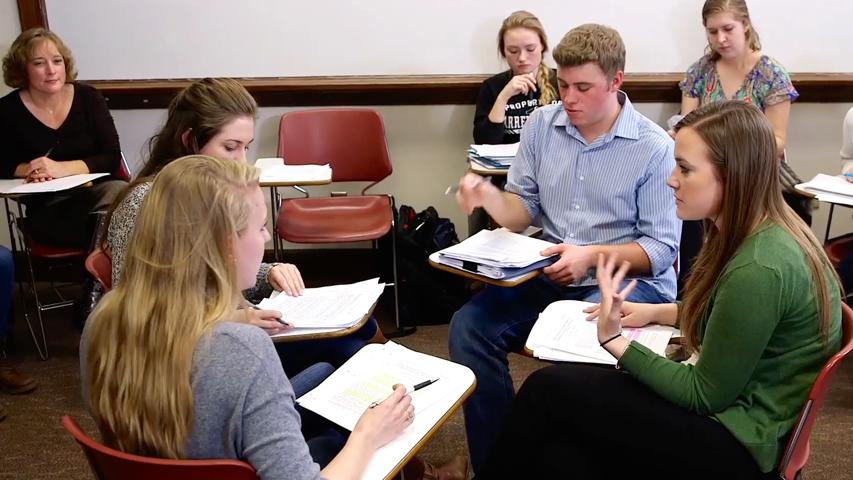
News Roundup: Active Learning Trends, Part-Time Student Success
This week, keeping up with active learning trends around the world and why institutions should focus on success for part-time students.
| Sign up for The ‘Q’ Newsletter for weekly news and insights. |
Lessons Learned: Building Prior Learning Assessment Structures
Students’ prior experiences often directly apply to their programs of study, says Jacqueline Hill, associate provost of academic affairs at Miami Dade College. Hill advocates using prior learning assessments to gauge students’ knowledge of the material and award credit, which can improve retention, enrollment, and student success. (The Evolllution)
Active Learning Experts on Keeping Up with Trends Worldwide
Active learning research and trends from around the world can benefit classrooms in the United States, according to many active-learning experts. Suggestions include measuring the effectiveness of learning spaces and instructor preparedness, as researchers in Australia, New Zealand, and the United Kingdom are doing, and using video technology to broadcast lectures to students on the other side of the world, among other ideas. (University Business)
Why Part-Time Students’ Success Matters
A study from EAB reveals that part-time student success in community colleges is essential for closing the achievement gaps for minority students. The report shows that Black and Hispanic students are more likely than White students to attend part time, which can negatively impact their ability to graduate. According to Christina Hubbard, colleges should focus on accommodating the needs of part-time students through measures such as creating shorter terms. (Inside Higher Ed)
Subverting That End-of-Semester Exhaustion
Because John Warner wanted to avoid student burnout, he asked students to submit their “big projects” early and spent the last two weeks of the semester having them engage in group activities and individual reflections. Warner discovered that the reflections were some of the best writing students had done through the course and the experiment was a success. (Just Visiting)
Partner News
Miami Dade College: College Promise Initiatives Encouraged to Incorporate New Strategies (Diverse: Issues in Higher Education)
University of Nevada, Reno: Higher Learning: Education in Nevada (Nevada Business)
Arizona State University: An ‘infinite’ plan for higher ed: Q&A with ASU President Michael Crow (EdScoop)
City College of San Francisco: ACUE Pinning Ceremony at CCSF (Eventbrite)
Hanover Research: Teaching Practices Relevant to All Faculty
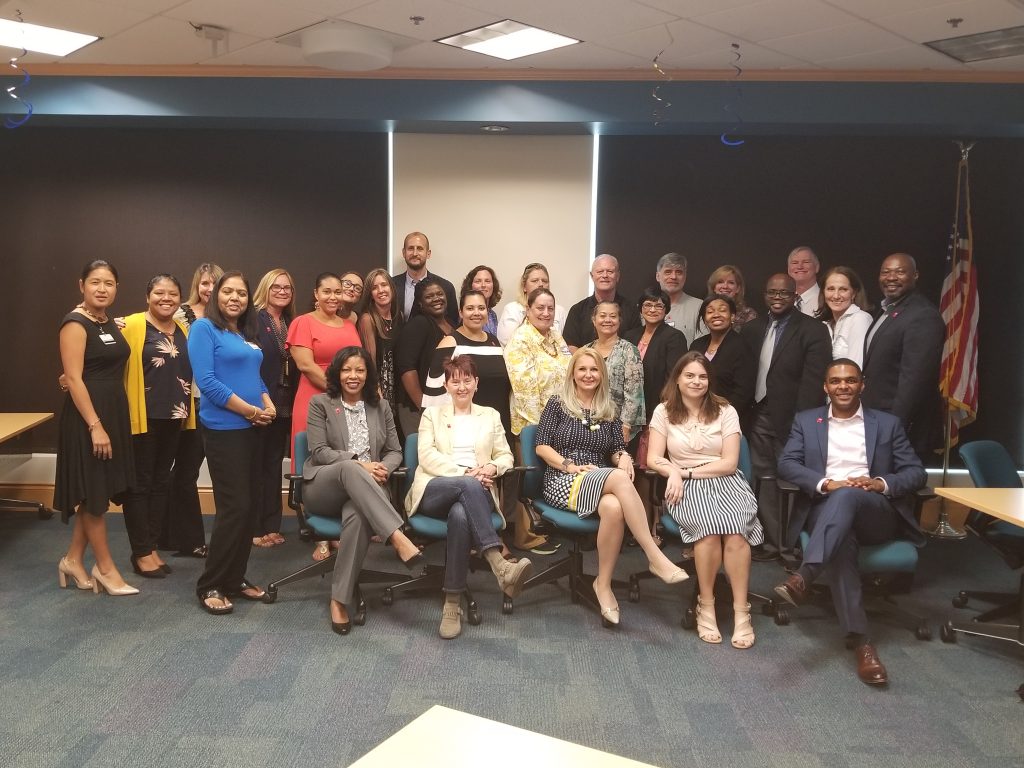
Broward College Holds Pinning Ceremony for ACUE-Credentialed Faculty
“You can teach an old dog new tricks,” Dr. Debra Renna, who completed ACUE’s course in the foundations of effective instruction, said at a Broward College celebration of teaching excellence last week.
Broward College honored its newly ACUE-credentialed faculty members at a pinning ceremony, where they also acknowledged recipients of the “Professor of the Year” awards, including an ACUE course facilitator, Dr. Billy Jones, and two ACUE-credentialed faculty members, Dr. John Donovan and Benjamin Botero.
Six deans and associate deans, some who completed the course in cohorts with their faculty, also attended and voiced their support for the program. As part of the ceremony, participants had the opportunity to reflect on the new teaching strategies they learned about and implemented successfully. Following the event, credentialed faculty shared additional overarching reflections about the program with us:
• “The material in the class is extremely interesting and has made me try new ideas in teaching and think about things in different ways. I am very happy to be part of this class. I have been teaching at the college level at other schools for over 20 years and I initially thought I would get a limited return on my time investment with this class and I was completely wrong.”
• “I feel that the program has brought many areas of interest to my attention, which I may have been overlooking or taking for granted. This has helped me fine tune my pedagogy as far as incorporating new strategies and making adjustments to existing ones.”
• “As I recognize the importance of life-long learning and am always striving for excellence, I am grateful for having had this opportunity to continue to improve the classroom experiences for my students.”
Congratulations to our members at Broward College!
You CAN teach an old dog new tricks
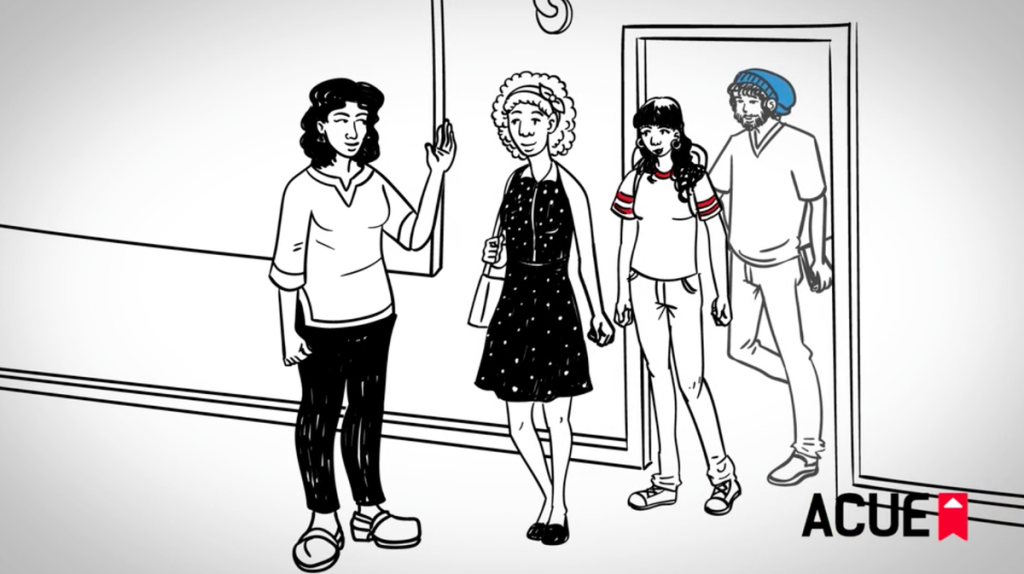
News Roundup: Teaching Introductory Courses
In this week’s newsletter, one perspective on which instructors should be teaching introductory courses and ideas for avoiding faculty burnout.
| Sign up for The ‘Q’ Newsletter for weekly news and insights. |
It Matters a Lot Who Teaches Introductory Courses. Here’s Why.
Students who take introductory courses with part-time faculty are less likely to continue with the subject matter and more likely to drop out of a STEM major, two new studies suggest. Because they often set the tone for students’ college careers, Daniel Chambliss advocates having the most experienced instructors teach introductory courses. (The Chronicle of Higher Education)
A Late Start Helps Higher Ed Students, Faculty Get Ahead
“Late-start” courses that commence a few weeks after the beginning of the semester work particularly well for driven students who may have other commitments. Modified schedules allow students to take courses at an accelerated rate, and faculty gain experience teaching a rigorous curriculum. (University Business)
Working the Online Crowd: Humor and Teaching with Tech
Joe Barnhart advocates infusing online courses with humor, using methods like witty subject lines in emails, riffs on pop culture, and goofy writing assignments to engage and motivate students. Students are more likely to become comfortable with their instructors, he writes. (Campus Technology)
4 Ideas for Avoiding Faculty Burnout
“Good teaching is emotional work,” David Gooblar writes. Because faculty are often prone to emotional exhaustion, Gooblar suggests that they pay attention to their well-being by taking the occasional evening off, learning to say “no” to additional commitments, getting enough sleep, and cultivating interests outside of teaching. (Vitae)
Can a ‘Family of Bots’ Reshape College Teaching?
Last year, Georgia Tech Professor Ashok Goel added robots into his mix of teaching assistants and challenged students to identify the machine voices among the humans. The use of “chatbots” freed up time for human TAs to answer more complex questions. Although Goel stresses that teaching and learning will always be a human endeavor, he sees robots playing various roles in classes in the future. (EdSurge)
Partner News
Salem State University: Faculty Complete Program to Enhance Student Success through Salem State Partnership with ACUE (Salem State)
Arizona State University: Crow calls on higher education to accelerate the pace of innovation (ASU Now)
Northern Arizona University: Reaccreditation Validates NAU’s Student-Centered Education (Flagstaff Business News)
University of the District of Columbia Community College: Acknowledging DC’s history, changing neighborhoods in officer training (WTOP)
Preparing Students for an Honest Dialogue

Faculty Spotlight: Aiwei Yao Borengasser, Obesity Researcher and Science Fair Judge
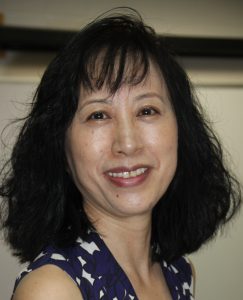 Dr. Aiwei Yao Borengasser is a biology and microbiology instructor in the biology department at the University of Arkansas – Pulaski Technical College. In addition to teaching, Aiwei has done extensive research on the ways obesity influences diabetes and the development of breast cancer, experience she often weaves into her lessons on biological molecules. Aiwei supports middle and high school science programs as a state-level science fair judge and by writing disease detection questions to challenge contestants at the Arkansas Science Olympiad.
Dr. Aiwei Yao Borengasser is a biology and microbiology instructor in the biology department at the University of Arkansas – Pulaski Technical College. In addition to teaching, Aiwei has done extensive research on the ways obesity influences diabetes and the development of breast cancer, experience she often weaves into her lessons on biological molecules. Aiwei supports middle and high school science programs as a state-level science fair judge and by writing disease detection questions to challenge contestants at the Arkansas Science Olympiad.
After completing ACUE’s foundations course at UA–Pulaski Tech, Aiwei plans to spend the summer reconstructing her teaching plan for the 2018-19 academic year using the practices she learned in the course, such as those she describes in this week’s Faculty Spotlight.
Discovering relevance
My typical students are not STEM majors; they’re taking one of my courses to fulfill a distributive requirement. They’re also scared that because they aren’t “into science” they won’t do well. When I start talking about scientific methods, I can see they are uneasy and that they don’t believe scientific methods have any relevance to their lives. This is when the “engagement trigger” technique I learned in the course was most useful. For instance, when I introduced the topic of hypotheses, I gave students a non-scientific-sounding scenario to start the lesson. “Consider this,” I said to them. “One day you discover you can’t get onto the Internet. What do you do? You come up with a hypothesis, such as, ‘Maybe when I vacuumed last night, I knocked out a cord.’ To test your hypothesis, you crawl under your desk to check, but you discover all the cords are in place. Your hypothesis is wrong, so you develop another hypothesis. You might think, ‘Hmm, I wonder if I forgot to pay the cable bill.’” When I had their attention, I asked for volunteers to tell me about a problem they solved recently, the steps they took, and so on, and I wrote their observations on the board. By the end of class, the students were fully invested. I asked them to write about what they learned on the subject of scientific methods. They had a lot to say, and they appeared to overcome those initial fears.
Mapping DNA mutations
ACUE’s concept mapping technique is a great tool for teaching DNA mutations. At the start of class, I asked my students to draw a circle and put the word “mutation” in the center. Then I asked them to draw several rays that extended from the circle and to write on each ray a term that represents a type of mutation. I discovered they could only come up with one or two examples and that all of their examples were diseases. I adjusted my lecture to address some of their misconceptions, describing, for instance, several positive outcomes from mutation, such as those occuring through evolution. After I lectured, I guided students in constructing another mutation concept map—this time, on the board. By now, each student could name several impacts of mutations, both good and bad, and there was a lot more energy in the room, with each student calling out 8 to 10 mutation outcomes. Using the diagram, I showed them how these mutations often relate to one another. Some students are logical and like to study from a list. But many of my students are visual learners who remember more when the information is in diagram form.
Restructuring to improve outcomes
I love to teach, but the ACUE course has made me reexamine my curricula. Employing the three-step process in the modules on aligning assessments, assignments, and activities with learning outcomes, I plan to redesign my biology and macrobiology courses for the fall semester and align my teaching methods to the learning outcomes I’m seeking for my students. In Step 1, I’ll ask myself whether I want them to recall information or analyze it. In Step 2, based on the outcome I’m looking for, I’ll determine whether to give students a quiz or a case study. Finally, in Step 3, I’ll identify the activities and assignments that will best align with the learning outcome. Does a group project make sense or is a research paper in order? Ultimately, I want my students to be able to apply their knowledge, not just take a test.

Insights: The Complexity of the Inclusive Classroom Dynamic
By Dr. Terri Jett
 As a graduate student, I was introduced to a text by one of my professors that helped me to consider the lens of which I might view my life and my work as an academic. That text, Breaking Bread: Insurgent Life of the Black Intellectual by bell hooks and Cornel West (1991), detailed how African Americans who make a deliberate choice to become a part of academic institutions, and thus lead a life of intellectual engagement, are often not fully accepted by the academy and are also seen as somewhat disconnected from their own people, the Black community. bell hooks states, “I have said in other writing that the difficulty many academics have when called to speak and write from an inclusive standpoint—one where ideas are looked at from a multidimensional perspective that begins with an analysis rooted in an understanding of race, gender, and class is due to the gap created by a lack of information. Since so many scholars and academics have been trained to think and study along narrow disciplinary lines, the knowledge they produce rarely addresses the complexity of our experience or our capacity to know” (p. 65).
As a graduate student, I was introduced to a text by one of my professors that helped me to consider the lens of which I might view my life and my work as an academic. That text, Breaking Bread: Insurgent Life of the Black Intellectual by bell hooks and Cornel West (1991), detailed how African Americans who make a deliberate choice to become a part of academic institutions, and thus lead a life of intellectual engagement, are often not fully accepted by the academy and are also seen as somewhat disconnected from their own people, the Black community. bell hooks states, “I have said in other writing that the difficulty many academics have when called to speak and write from an inclusive standpoint—one where ideas are looked at from a multidimensional perspective that begins with an analysis rooted in an understanding of race, gender, and class is due to the gap created by a lack of information. Since so many scholars and academics have been trained to think and study along narrow disciplinary lines, the knowledge they produce rarely addresses the complexity of our experience or our capacity to know” (p. 65).
Walking that fine line on a personal level becomes intensified for the African American intellectual who makes a choice, as I did, to join the faculty at a predominantly White institution. I remember sitting in a meeting of department chairs some years into my career where a colleague made the remark that Black women were hard to recruit. But the fact of the matter is that how we decide where we would like to live and work is no different than anyone else. I wanted to be at an academic institution that truly valued innovative and creative teaching, maintained small class sizes, and offered opportunities to teach, not just in a department, but also as part of a core curriculum that all students, regardless of their major, would have to complete. This spoke to my interdisciplinary background because I have a degree in Ethnic Studies. I also liked that the Department of Political Science faculty members were very much engaged in work in the community, demonstrating for our students firsthand the relevance and significance of what we teach in practice. They, our students, would see in us that our actions are informed by our knowledge. This resonated well with my view of myself as an African American intellectual, expected to move beyond the so-called “ivory tower” and to remain firmly grounded in the life of addressing injustices that face my own people.
This insurgent intellectual life, as defined by hooks and West, helps me create an inclusive classroom space at a predominantly White institution, because, as an African American woman, I have to work hard to maintain a sense of authority in that space, while simultaneously allowing for disparate voices to enter, including those that challenge my very own dignity. I do this by not hiding behind the illusive cloud of objectivity that is sometimes advocated particularly in political science courses. I reveal my work in the community as it substantiates what I teach, I bring guest speakers into my classes that I actually know very well because of our shared efforts to address social justice issues, and I create a space for students to reveal their visions of themselves as change agents in our society. Their political writing becomes much more informative and developed as they learn to interject their true voice and values, and so I serve as a model day in and day out for a space that includes both their voices and mine. For most of my students, I am the first African American woman teacher that they have ever experienced, and so I am working against some stereotypes that they have been fed which have very little to do with who I am at my core. So we take our time at the beginning of the semester truly getting to know one another, where we come from, and what we believe, and then I take the lead and guide the students through the curriculum I have chosen for my course that will prepare them to be in honest dialogue with anyone and everyone with whom they have limited familiarity, but who they need to learn to live and work with well into the future.
Dr. Terri Jett is an associate professor of political science and special assistant to the provost for diversity and inclusivity at Butler University.
Reference
hooks, b., & West, C. (1991). Breaking bread: Insurgent life of the black intellectual. Toronto, Canada: Between the Lines.
